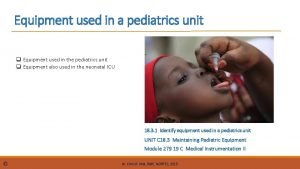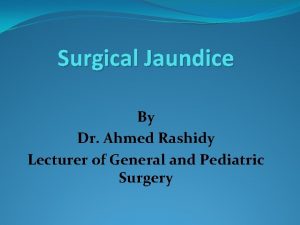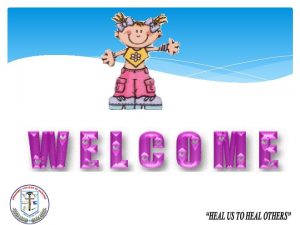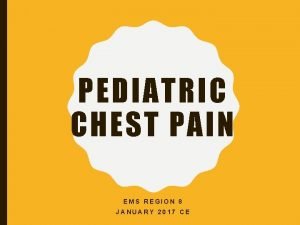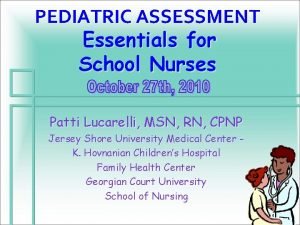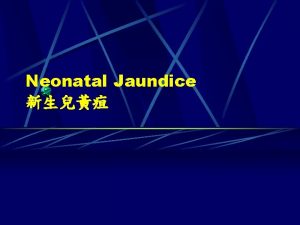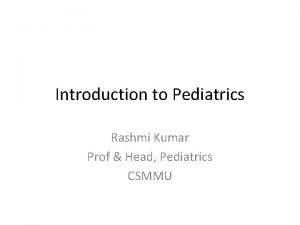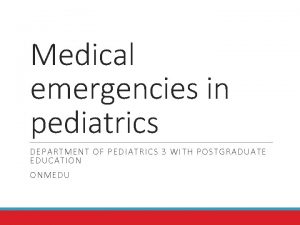Equipment used in a pediatrics unit q Equipment












- Slides: 12

Equipment used in a pediatrics unit q Equipment used in the pediatrics unit q Equipment also used in the neonatal ICU 18. 3. 1 Identify equipment used in a pediatrics unit UNIT C 18. 3 Maintaining Pediatric Equipment Module 279 19 C Medical Instrumentation II © dr. Chris R. Mol, BME, NORTEC, 2015

Classification of children in Pediatrics Neonate first 28 days of life Infancy birth to 1 year Toddler 1 to 3 years Pre-pubertal 10 to 13 years © dr. Chris R. Mol, BME, NORTEC, 2015 Pre-schooler 3 to 6 years School-ager 6 to 10 years Adolescent 13 to 18+ (21 in the US) years Paediatric equipment

Children are not ‘little adults’ Children have a different body size & maturation The smaller body of an infant or neonate is substantially different physiologically from that of an adult. Congenital defects, genetic variance, and developmental issues are of greater concern to pediatricians than they are to adult physicians. The clinician must take into account the immature physiology of the infant or child when considering symptoms, prescribing medications, and diagnosing illnesses. Children are more vulnerable to environmental hazards • Children (adolescents!) may take unreasonable risks due to cognitive immaturity and "risk-taking" behaviours • obstructed breathing (swallowed foreign object) • malnutrition • ingested poisons • birth related problems • drowning • snake bites & scorpion stings • HIV/Aids soil consumption © dr. Chris R. Mol, BME, NORTEC, 2015 Paediatric equipment

Children are not ‘little adults’ It is more difficult to communicate with children • Pre-reading children cannot read warning signs & labels • Children cannot always tell their complaints Children cannot (always) make decisions for themselves. The issues of guardianship, privacy, legal responsibility and informed consent must always be considered. The concept of legal consent when considering treatment options, especially in the face of conditions with poor prognosis or complicated and painful procedures, means the pediatrician must take into account the desires of many people, not just the patient. © dr. Chris R. Mol, BME, NORTEC, 2015 Paediatric equipment

Stages in the management of a sick child admitted to the hospital Triage is the process of rapidly screening sick children soon after their arrival in hospital, in order to identify: • those with emergency signs, who require immediate emergency treatment; • those with priority signs, who should be given priority in the queue so that hey can be assessed and treated without delay; • non-urgent cases, who have neither emergency nor priority signs. Pediatric examination often includes: lab analysis of blood, microscopy analysis of urine & faeces, pulse oximetry and chest x-ray Differential diagnostic is a process of elimination of alternative possible diseases, by using evidence such as symptoms, patient history, and medical knowledge. © dr. Chris R. Mol, BME, NORTEC, 2015 Paediatric equipment

Photo Therapy unit A phototherapy device is used to treat hyper-bilirubinemia, a disease which often occurs in babies and is characterized by high bilirubin concentrations in the blood. Jaundiced new-borns have yellow discoloration of the white part of the eye, and yellowing of the face, extending down onto the chest. Free standing Phototherapy unit Devices using overhead lamps can be freestanding on casters, ceiling or wall mounted, or attached to infant radiant warmers or infant incubators; some units have height and hood angle adjustments. Bassinet-style units, in which the infant is placed in a plastic bassinet containing a bank of lights in an overhead case, are also available. Baby with high Bilirubinemia © Bassinet-style Phototherapy unit dr. Chris R. Mol, BME, NORTEC, 2015 Paediatric equipment

Radiant Warmer Radiant warmers (and incubators) are used to maintain the body temperature of new-born infants. This is done to minimize the energy that is required for metabolic heat production. Hypothermia at birth is one of the most important risk factors for new-born mortality. © dr. Chris R. Mol, BME, NORTEC, 2015 Paediatric equipment

Radiant Warmer, Incubator, Resuscitaire Radiant warmer: heat only for new-borns © Incubator: long term environment dr. Chris R. Mol, BME, NORTEC, 2015 Resuscitaire: intensive care at birth Paediatric equipment

Infant Blood pressure machine The ‘pediatric use’ of a blood pressure machine is not very different from the ‘adult use’. © dr. Chris R. Mol, BME, NORTEC, 2015 Paediatric equipment

Infant weighing scale A baby scale is a specially-designed scale to monitor the progress of a baby’s physical development. If a baby is born prematurely, it is often important to closely monitor their weight gain with a baby scale, more often than for on-time babies. © dr. Chris R. Mol, BME, NORTEC, 2015 Paediatric equipment

Laryngoscope Laryngoscopy (larynx + scopy) is a medical procedure that is used to obtain a view of the vocal cords and the glottis. Laryngoscopy may be performed: • to facilitate tracheal intubation during general anesthesia or cardio-pulmonary resuscitation • to execute procedures on the larynx or other parts of the upper trachea-bronchial tree, for example biopsies. © dr. Chris R. Mol, BME, NORTEC, 2015 Paediatric equipment

END The creation of this presentation was supported by a grant from THET: see https: //www. thet. org/
 Equipment used in pediatrics
Equipment used in pediatrics Normal vital signs of newborn
Normal vital signs of newborn Vital signs normal range
Vital signs normal range Type of jaundice
Type of jaundice Abdominal restraint
Abdominal restraint Volutrol administration set
Volutrol administration set Chest pain in pediatrics
Chest pain in pediatrics Normal vital signs for adults
Normal vital signs for adults Pain scale 1-10 examples
Pain scale 1-10 examples Jaundice physical exam
Jaundice physical exam Define modern concept of child care
Define modern concept of child care Modern concept of pediatric nursing slideshare
Modern concept of pediatric nursing slideshare Shelf exam percentiles
Shelf exam percentiles
